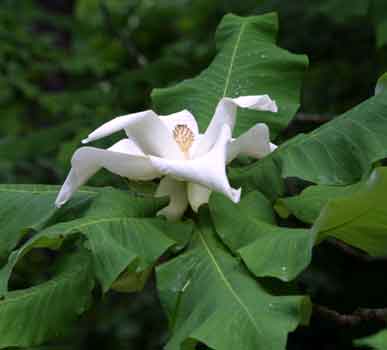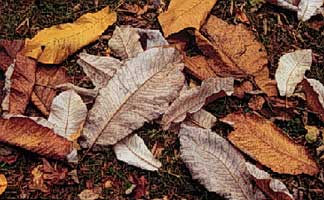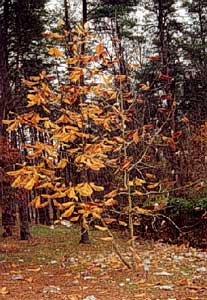 Bigleaf magnolia - Magnolia macrophylla
Bigleaf magnolia - Magnolia macrophylla
Magnolia family (Magnoliaceae)
Bigleaf magnolia has huge leaves that are 12 to 36 inches long, and ivory-colored flowers that average 8 to 10 inches across. The tree's coarse appearance makes it difficult to use in residential areas. It can be used as a specimen tree or shade tree in parks or other large areas.
It is found in Kentucky, which is home to the national champion - a tree in Tight Hollow, Ky. measured 108 feet tall with a 42-foot spread.
- Native habitat: Ohio to Florida, Arkansas to Louisiana. Growth habit - Oval, pyramidal, irregular silhouette.
- Growth habit: is moderate.
- Tree size: Reaches an average height of 30 to 40 feet.
- Flower and fruit: Flowers are creamy white and up to a foot across. Flowers are borne in summer and have a pleasant fragrance. The inner three petals have purple stains near their base. Fruit is round to egg-shaped, rose-colored and about 3 inches long. Fruit is persistant and attracts birds.
- Leaf: Leaves are alternate, simple, 12 to 36 inches long and 7 to 12 inches wide. They are bright green above and silvery gray below. Petioles are 2 to 4 inches long. Fall color is yellow.
- Hardiness: Winter hardy to USDA zone 5.
 Additional information:
Additional information:
Bigleaf magnolia is a deciduous tree but is semi-evergreen in the deep South. Bigleaf magnolia occurs over a large area but individual trees are scarce. It is found in Kentucky, which is home to the national champion - a tree in Tight Hollow, Ky. measured 108 feet tall with a 42-foot spread.
Bigleaf magnolia was introduced into the landscape in 1800.


